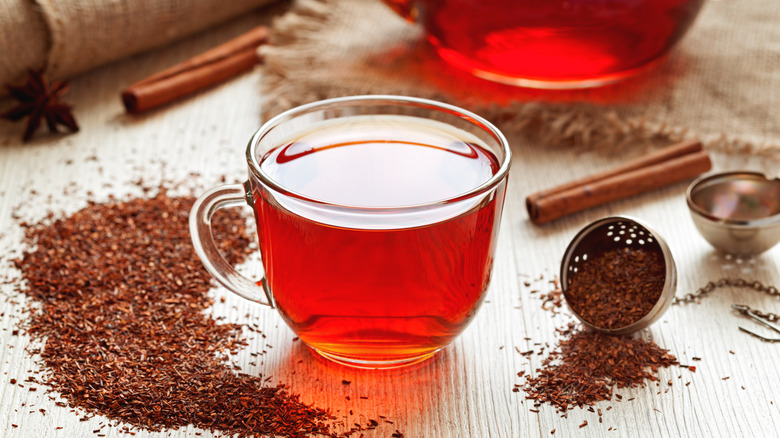What Makes Rooibos Tea So Unique?
You wouldn't know it to look at the tea section of the grocery store, but most of the teas we drink all come from the same plant, Camellia sinensis. There are exceptions, of course, but Teasource explains that black tea, green tea, white tea, and oolong tea are all made from this same plant, native to Southeast Asia. The differences among these kinds of tea are determined primarily based on the way the tea is processed after it's harvested. However, there are forms of tea that are not made from Camellia sinensis.
Herbal teas can be made with a wide variety of plants, like peppermint and chamomile, and they can be flavored with any combination of spices and fruits. One of the distinctions between herbal tea and "real" tea is that beverages made with Camellia sinensis are caffeinated, while pure herbal teas are not (per Tea Forté). Though herbal tea may not be "real" tea in the truest sense, since herbal teas (or tisanes) are prepared by steeping plants in hot water, we still call them tea. There's one tea that stands out as utterly unique among the others in the herbal tea category, and that's rooibos tea. But, what's so special about it?
Rooibos tea only grows in South Africa
Rooibos tea comes from a bushy herb that's native to a mountainous region of South Africa called Cederberg, which is north of Cape Town, according to Teatulia. Dutch settlers in South Africa, looking for a more affordable alternative to pricy black tea in the 1700s, began brewing tea from the rooibos bush, which yields a rich reddish-brown beverage. Rooibos is harvested and processed much like traditional tea, and South Africa produces about 15,000 tons of rooibos annually, exporting around 7,000 tons of it to countries around the world. Though attempts have been made to cultivate rooibos outside of South Africa, none have been successful. However, researchers are looking into South Africa's climate and soil which may the key to why the plant only flourishes in one place on Earth. (per Klip Op Mekaar).
Rooibos is exceedingly flavorful and full-bodied, and Teatulia describes its flavor as containing "smoky, sweet, woody, grassy, vanilla, floral, geranium, honey, herbal and caramel" notes. Because rooibos is so rich, it's ideally suited for a range of cooking purposes. Oregon Live details just a few of the uses for rooibos in the kitchen, like flavoring ice cream, yogurt, sauces, beverages, and even meat marinades. The rich nutty flavor of rooibos tea is delicious with caramelized onions, and it's so versatile that it even works in elegant recipes like our tea cookies.

